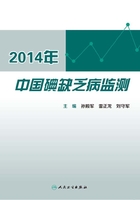
上QQ阅读APP看书,第一时间看更新
重庆市碘缺乏病监测报告
■ 李心术 吴成果 谢 君 陈亚林 黄文利 陈 静 周倩如 张 洁
(重庆市疾病预防控制中心)
摘要
目的 了解重庆市碘缺乏病现状和居民碘营养水平,为调整食盐加碘浓度提供科学依据。
方法 按“人口比例概率抽样方法”(PPS)抽样,在全市抽取30个区县开展8~10岁儿童甲状腺(B超法)、盐碘、尿碘监测,孕妇尿碘、盐碘监测。
结果 1610名8~10岁儿童甲状腺肿大率为3.23%,合格碘盐食用率为94.53%,尿碘中位数为222.70μg/L,﹤50μg/L占2.92%,100~199μg/L占30.75%,≥300μg/L占27.33%;612名孕妇合格碘盐食用率为94.93%,尿碘中位数为162.70μg/L,﹤150μg/L的占43.31%,150~249μg/L的占33.50%,250~499μg/L的占18.95%,≥500μg/L的占4.25%。
结论 重庆市儿童甲肿率、盐碘、尿碘指标持续达到国家“消除碘缺乏病标准”,但存在儿童尿碘超过适宜量,部分孕妇碘营养不足的问题。适当下调碘盐浓度,孕妇额外补碘。
ABSTRACT Objective To evaluate the effects of prevention and control for iodine deficiency disorders so as to provide scientific evidences. Methods 30 counties were selected using proportionate to population size method (PPS)in Chongqing in 2014.The thyroid volume of children aged 8-10 years was examined by B-ultrasonography.Urinary iodine and salt iodine were investigated among the children and pregnant women. Results 1610 students were investigated.The total goiter rate was 3.23%and the consumption rate of qualified iodized salt was 94.53%.The median of urine iodine of children was 222.70μg/L.Below 50μg/L, between 200 and 299μg/L, above 300μg/L of urine iodine were accounted for2.92%, 30.75% and 27.33%, respectively.612 pregnant women were investigated.The consumption rate of qualified iodized salt was 94.93%and the median of urine iodine of children was 162.70μg/L.Below 150μg/L, between 150 and 249μg/L, between 250 and 499μg/L, and above 500μg/L of urinary iodine were accounted for 43.31%, 33.50%, 18.95%and 4.25%, respectively. Conclusions The indexes of total goiter rate, salt iodine, and urinary iodine have reached the national standard of eliminating iodine deficiency disorders.But the median urinary iodine of children was above requirements and the median urinary iodine of pregnant women was insufficient in Chongqing.The concentration of iodized salt should be decreased for the public, but salt intake was increased for pregnant women.
为掌握我市碘缺乏病病情变化趋势,动态评价人群碘营养状况,适时采取针对性防治措施和调整干预策略,根据《2014年度重庆市重大公共卫生项目疾病预防控制项目实施方案》(渝卫办疾控发〔2014〕271号)和《2014年重庆市碘缺乏病病情监测技术方案》(渝疾控〔2014〕336号)要求,我中心组织相关区县开展了碘缺乏病病情监测工作,现将监测情况报告如下。